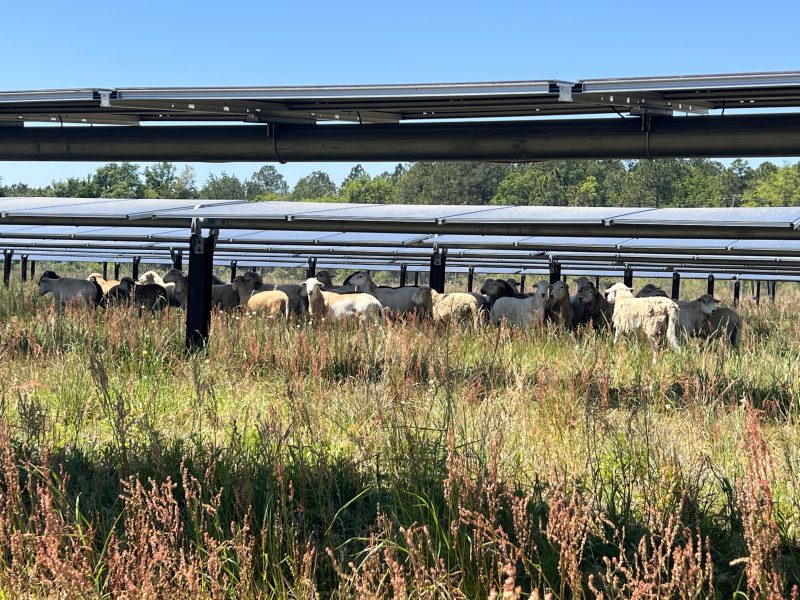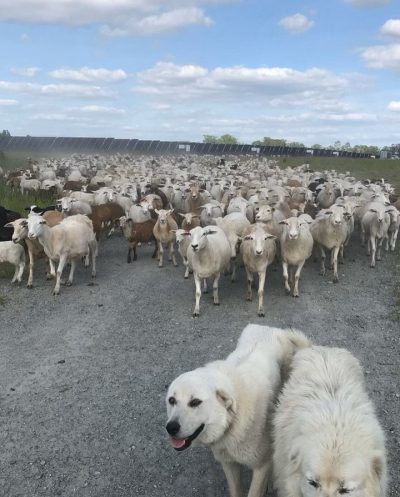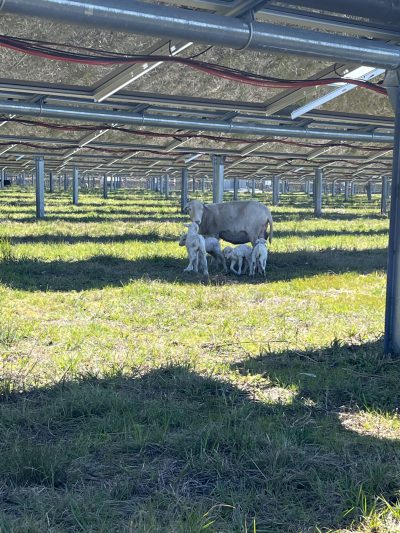By now you may have heard the term “solar grazing” or “agrivoltaics”, but may not understand what the terms mean. Solar grazing and agrivoltaics are both terms used to describe a new trend for small ruminants that is making its way around the county. Simply put, the terms describe using small ruminants, particularly sheep, to provide vegetation management on solar farms. Solar farms occupy significant tracts of land and companies must maintain and acceptable amount of vegetative cover – bare ground would result in soil erosion and degradation to the environment while unmanaged vegetation would turn into a veritable jungle over time. Vegetation maintenance via mowing becomes very expensive, especially in the south where vegetation may need to be controlled almost year-round.
Sheep present a regenerative and renewable approach to vegetation management for the green industry. Solar grazing is a dual-use farming technique. It combines both agricultural practices and solar energy production. It refers to the installation of solar panels on farmland or the utilization of agricultural fields to generate solar power. This concept allows for the simultaneous use of land for forage production and renewable energy generation, maximizing the benefits of both agriculture and solar energy.
Why sheep? You could use any grazing livestock for vegetation management. However, sheep cause much less damage to the solar panels than do cattle or goats making them the best fit for the job. Jim Malooley, Senior Manager with Regenerative Energy Operations at Silicon Ranch, states that even with excellent stocking rates of sheep to the solar fields, you still end up having to mow the fields twice a year. However, twice a year is better than once or twice a month.
You may have driven along I-10 recently and noticed that there is quite a bit of shade under solar panels (it is the panel’s job to intercept sunlight). This amount of shade means that not every kind of forage will work. The choice of crops in solar grazing systems is crucial. Certain crops, such as shade-tolerant vegetables, herbs, or forage plants, are well-suited for this setup. Careful planning and selection of crops ensures that they can thrive in the partially shaded conditions created by the solar panels. Additionally, farmers need to consider factors such as irrigation systems, spacing, and maintenance requirements to effectively manage the combined solar and agricultural operation.
You may be wondering how you can get into this? Jim Malooley, from Silicon Ranch, suggests you can take two approaches. One approach is to buy your own sheep flock and solicit contracts with energy companies for vegetation management. This approach provides income for both the vegetation control work, as well as marketing the lamb crop. However, this means you have all the risks and requirements for the farming overhead. What overhead? Well water is a major problem, there is typically not going to be a water spicket at every turn, so you will either have to pump in or haul in water. While the perimeter of the solar farm is fenced, you will still have to provide cross fencing to control the rotational grazing of the solar farm. These are just a few of the unique challenges to solar grazing.
Another approach to getting involved with solar grazing is to work directly for an electrical company or a vegetation management company. This means you get to run the operation, but the overhead and risk are left to the company. If you don’t have the resources to manage you own vegetation contract, this is an option to get started with solar grazing.
Solar grazing represents a sustainable approach to land use, supporting both renewable energy generation and food production. It promotes the transition to clean energy while addressing the challenges of land scarcity and climate change. Solar Grazing is not for everyone, but there will be more opportunities as solar farms continue to grow. So next time you hear the phrase “solar grazing” or drive by a solar farm and see sheep grazing, you will know what it is all about.
- Managing Wild Hogs in theFlorida Panhandle: Strategies for Farmers and Landowners - October 24, 2025
- 2025 Small Ruminant Grazing Field Day – November 5 - October 3, 2025
- After an Eventful Winter, Inspect and Prepare Equipment for the Growing Season - April 11, 2025



